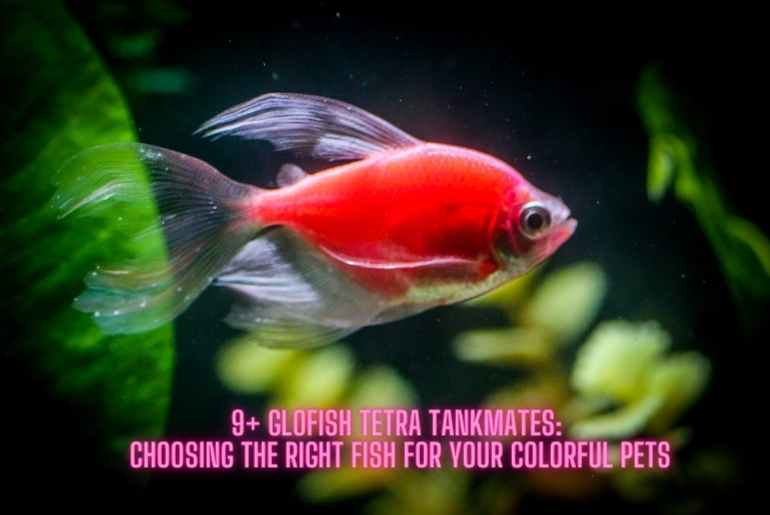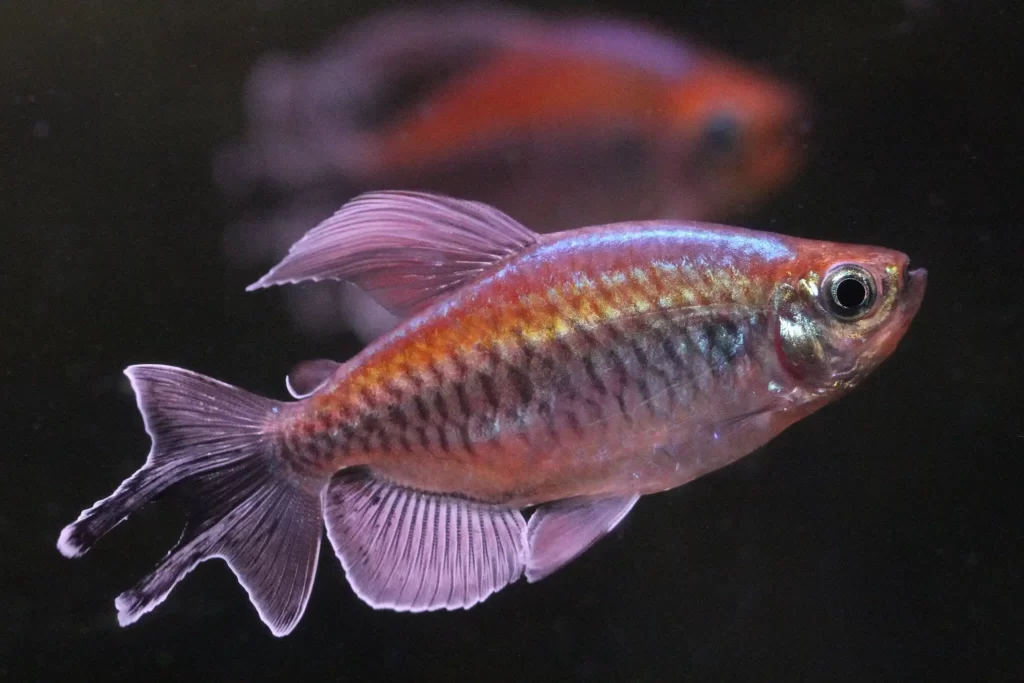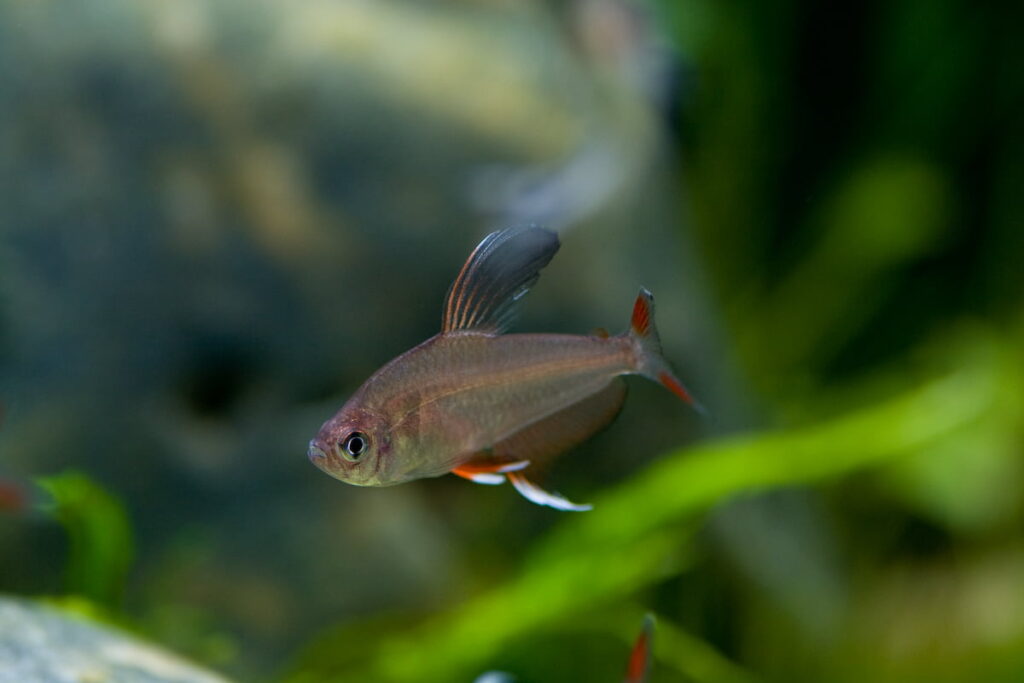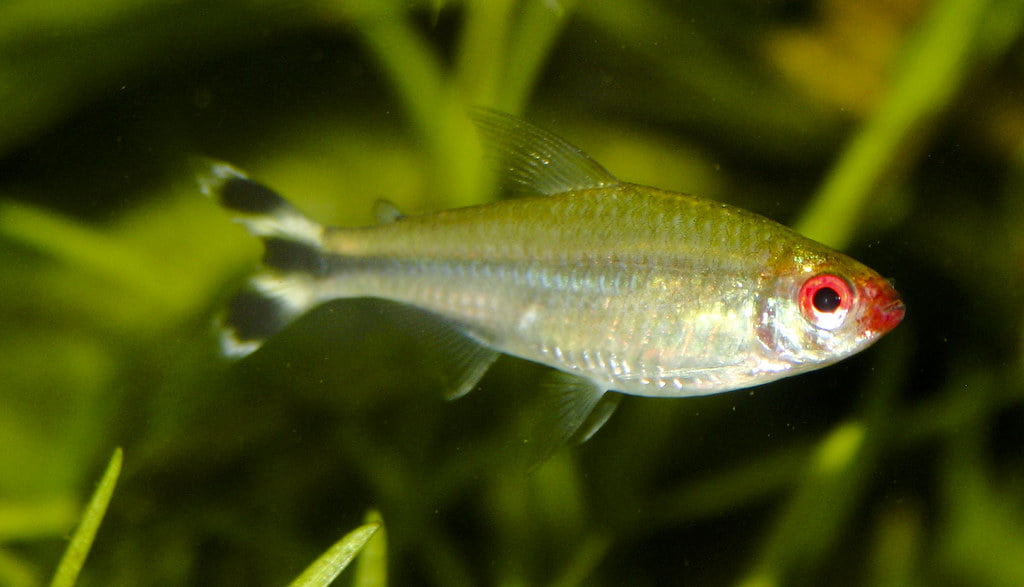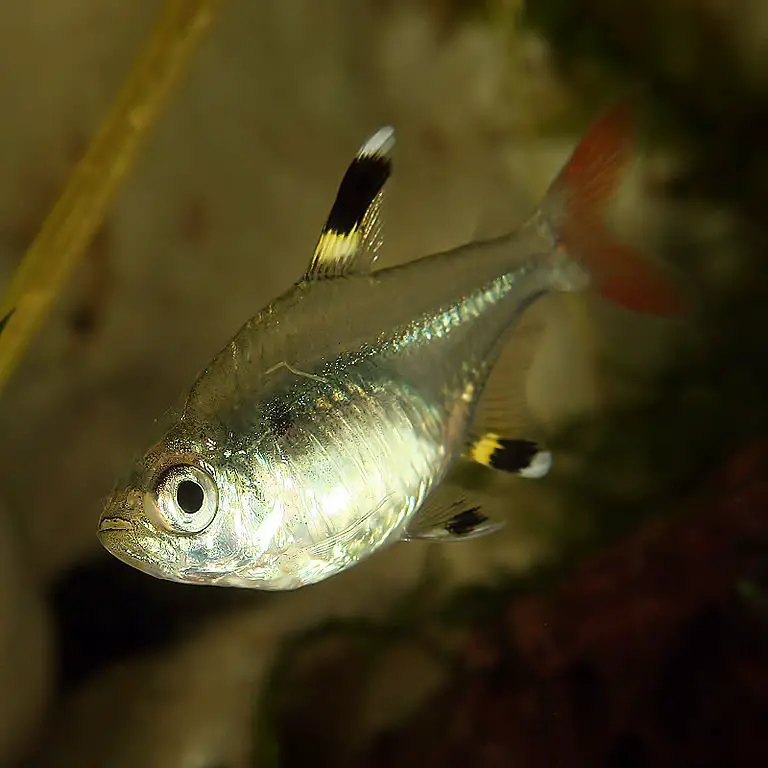Are you in search of great companions for your GloFish Tetra? Renowned for their peaceful demeanor and low-maintenance care, GloFish Tetras make excellent additions to community fish tanks. In this article, we will explore the ideal fish that can coexist harmoniously with GloFish Tetras.
Quick Answer:
Choosing suitable tank mates for your GloFish Tetra involves considering similar size, temperament, and water condition requirements. Among the best GloFish Tetra companions are Neon Tetra, Danios, Rasboras, Cardinal Tetra, and Corydoras—fish that match in size and share a peaceful temperament, thriving in comparable water conditions.
5 Things to Consider Before Choosing GloFish Tetra Tank Mates
Before introducing any companions to your GloFish Tetra aquarium, thoughtful consideration of various factors is essential. Understanding the unique care requirements, temperaments, tank size needs, and compatible water parameters, including temperature and pH levels, is crucial. Additionally, tailoring the diet to suit the diverse inhabitants ensures a harmonious aquatic community.
We will now delve into each of these crucial considerations, exploring why they matter and how they shape the dynamics of your aquatic community, ensuring a harmonious and thriving environment for your GloFish Tetras and their potential companions.
1. Research Fish Care Requirements and Temperament
Before choosing tank mates for GloFish Tetra, it’s crucial to conduct thorough research on each species. Understanding the unique care requirements and temperament of different fish will enable you to make an informed decision and select species that align with the needs and behaviors of your GloFish Tetra.
For instance, GloFish Tetras are known for their peaceful nature and a preference to swim in schools, making them ideal candidates for community tanks. When seeking GloFish Tetra tank mates, opt for small, peaceful species like neon tetras, Corydoras catfish, or cherry barbs to create a harmonious environment within your aquarium.
These compatible GloFish Tetra tank mates share similar needs and behaviors, promoting a tranquil coexistence and a visually captivating aquatic display
2. Consider the Size of Your Aquarium
The size of the aquarium significantly impacts the choice of tank mates for GloFish Tetras. Given that GloFish Tetras usually grow to about 2.5 inches, adhering to the ‘one inch of fish requires one gallon of water’ rule is vital.
When considering a community tank with GloFish Tetras, it’s advisable to opt for a 30 to 40-gallon tank at a minimum. Since these tetras thrive in schools, maintaining at least six of them in a tank is crucial to ensure their comfort and well-being.
In a larger tank, the likelihood of fish becoming territorial and aggressive decreases as they have more space to establish their zones, fostering a peaceful coexistence among the aquatic community.
Also Read: Number Of GloFish Tetra to Tank Size Ratio
3. Compatibility with GloFish Tetra
Making sure that the fish you choose can get along with GloFish Tetras is really important. Just looking at their size is not enough.
Some fish might be similar in size, such as Tiger Barb, but won’t be good tank mates for GloFish Tetras. On the other hand, some bigger and peaceful fish, such as Gouramis, can actually live happily with GloFish Tetras because they are calm and friendly.
So, it’s not only about the size of the fish; we also need to think about how they act and behave. Understanding the behavior and social habits of different fish is key to having a happy and peaceful group of fish in your aquarium. Choosing fish that not only match in size but also in personality is crucial for a well-balanced aquatic community.
Also Read: Are GloFish Tetras Aggressive
4. Water Parameters
Understanding the right water conditions for GloFish Tetras is really important. Fish come from all sorts of places, like streams, lakes, or rivers, and each place has its own unique kind of water. GloFish Tetras, for instance, like their water to be not too hot or too cold—kind of like a perfect bath temperature. They prefer it between 72 to 80 degrees Fahrenheit. They also prefer their water to be somewhat acidic and somewhat basic, not too much of either.
The pH, which tells us how acidic or basic the water is, should be between 6.8 and 7.8. It’s a bit like how some people like their lemonade a bit tangy, not too sour, and not too sugary.
To maintain these optimal water conditions, regular water changes are key. Doing a 10-25% water change every week helps in keeping the water fresh and the parameters in check.
Additionally, using a good water conditioner and investing in a reliable aquarium filter, heater and thermometer can assist in maintaining a stable and healthy aquatic environment for your GloFish Tetras.
5. Feeding Habits
The next important factor to consider is the dietary needs, especially when thinking about GloFish Tetra tank mates. Just as people from different regions have varied food preferences and nutritional needs, fish also require specific diets. This is why you’ll find fish food designed to cater to the diverse tastes and dietary requirements of different fish species.
Reputable companies often create specialized foods for various fish types, such as Tetras, Bettas, and Goldfish, ensuring their unique nutritional needs are met. When selecting tank mates for your GloFish Tetras, it’s essential to choose those with similar dietary requirements. This ensures that all fish in the tank, including your vibrant GloFish Tetras, receive a well-rounded and nutritious diet suitable for their overall health and vitality.
Compatibility Table
I have listed the types of fish you can mix with your glofish tetra so that it is easier for you to choose!
| Tankmates for Glofish tetra | Can You Keep Them With Glofish? |
| Angelfish | Caution |
| Barb | Yes |
| Betta | Yes |
| Big Catfish | No |
| Malawi Cichlid | No |
| Tanganyika Cichlid | No |
| African Cichlid | No |
| New World Cichlid | Caution |
| Cory cat | Yes |
| Danio | Yes |
| Discus fish | Yes |
| Goldfish | No |
| Gourami | Caution |
| Guppy | Yes |
| Hatchet | Yes |
| Killifish | Yes |
| Loach | Yes |
| Molly | Yes |
| Minnow | Yes |
| Platy | Yes |
| Pleco | Yes |
| Rainbowfish | Yes |
| Rasbora | Yes |
| Shark (other) | Caution |
| Swordtail | Yes |
| Tetras | Yes |
15 Best Tank Mates for Your GloFish Tetra
Diversifying your aquarium with compatible companions can enhance the allure and balance of your GloFish Tetras’ habitat. In this guide, we present 15 top-notch tank mates to join your GloFish Tetras, adding to the mesmerizing visual display and community rapport in your tank. We’ve categorized these fish based on their behavior, compatibility, water preferences, dietary requirements, tank size considerations, and aesthetic appeal. This curated selection ensures you can choose the perfect GloFish Tetra tank mate effortlessly.
1. Black Neon Tetras
The Black Neon Tetra is a delightful choice as a tank mate for GloFish Tetras, harmonizing in both temperament and water preferences. Let’s delve into why they make an excellent combination.
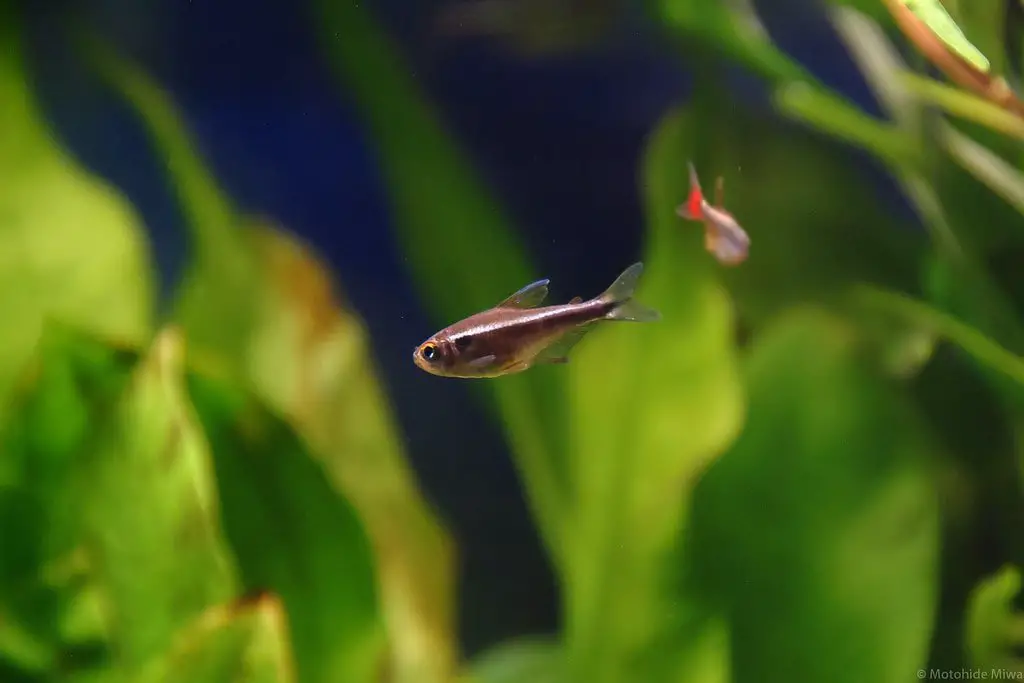
| Temperament | Peaceful shoaling fish |
| Size | 1.5 inches (3 cm) |
| the temperature of the water | 73° to 81°F (23° to 27°C) |
| the pH of the water | 5.5 to 7.5 |
Compatibility and Behavior
Black Neon Tetras possess a peaceful demeanor, perfectly aligning with the nature of GloFish Tetras. Their modest size of around 1.5-2.5 inches and lively behavior complement the playful disposition of GloFish Tetras.
Water Parameters
Maintaining suitable water conditions is paramount for a successful tank. Black Neon Tetras prefer a slightly acidic to neutral pH (6.0 – 7.0) and a temperature range of 72-79°F (22-26°C), harmonizing seamlessly with the preferences of GloFish Tetras.
Dietary Needs
Their dietary requirements are similar to those of GloFish Tetras, enjoying a diet consisting of flakes, micro pellets, and occasional live or frozen foods. This dietary harmony simplifies feeding routines and ensures both species receive balanced nutrition.
Tank Size and Grouping
A tank of 20 gallons or more provides ample space for a harmonious community of GloFish Tetras and Black Neon Tetras. Black Neon Tetras exhibit shoaling behavior, thriving in a group of at least 6, enhancing their social dynamics.
Visual Appeal and Community Dynamics
The sleek black bodies of Black Neon Tetras adorned with striking neon stripes add a captivating contrast and visual interest to the tank. Their calm demeanor and affinity for schooling contribute to a serene and visually appealing aquatic community.
Here is a detailed article about black neon tetras!
2. Danios
Danios are a popular freshwater fish that make great companions for GloFish. They come in many different types with fun colors and patterns, like Zebra Danios and Leopard Danios.
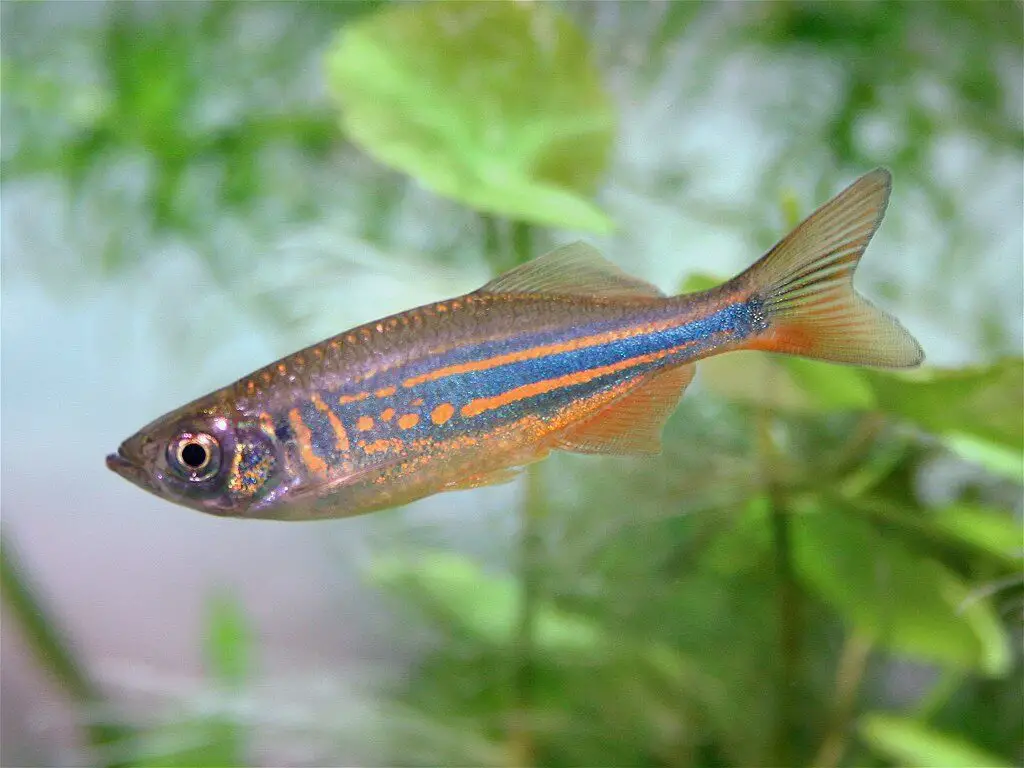
| Size | Around 2 inches |
| Temperament | Peaceful and shy |
| pH | 7 to 7.8 |
| Temperature | 70° and 78° F |
Compatibility and Behavior
Danios generally reach 1-1.5 inches as adults, about the same comparable size as GloFish Tetras. Their peaceful spirits and active swimming nature makes them a great match for playful GloFish. Both fish stay relatively small, so their similar sizes ensures safe coexistence and fun interactions in the tank.
Water Parameters
Danios thrive in water with a pH between 6.5-7.5 and a temperature range of 70-77°F. This aligns closely with GloFish Tetras. The similar water preferences of Danios and GloFish means they can be comfortable tank mates with minimal parameter adjustments needed to keep both species healthy and vigorous.
Dietary Needs
Danios have an omnivorous diet and will eat most fish foods. They enjoy small flakes, pellets, freeze-dried bloodworms, brine shrimp, and vegetables like blanched spinach or zucchini. This diet complements the dietary staples that GloFish Tetras also thrive on. The similar dietary profiles ensure both fish can be successfully fed with small, varied meals.
Tank Size and Grouping
At least a 20-gallon tank is recommended to house 6-10 Danios. They thrive in groups and appreciate space to explore and dash around the tank. A 20-gallon provides enough territory while accommodating adequate schools of Danios and a group of GloFish Tetras. With their smaller sizes, both fish can comfortably share a tank this size or larger, finding plenty of room to socialize without overcrowding.
Visual Appeal and Community Dynamics
With their variety of colors and patterns, Danios adds visual interest that complements the bright tones of GloFish. Their peaceful spirits and bustling energy ensure a lively yet calm aquatic community.
3. Dwarf Cichlids
Dwarf Cichlids are colorful freshwater fish known for their patterns, personalities, and small stature, making them perfect Tank mates for GloFish Tetra. Despite their tininess, they make a big visual impact in any tank.
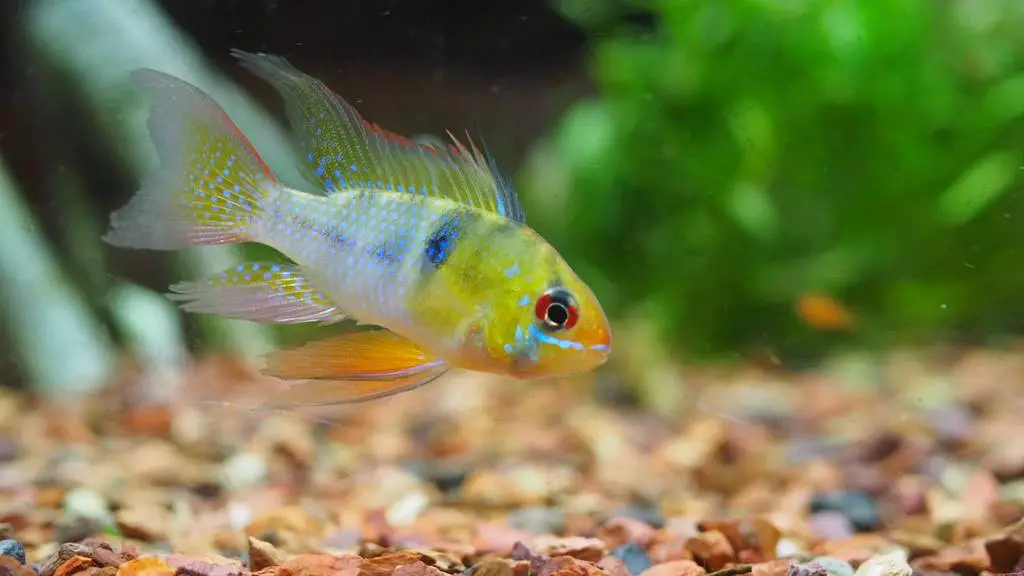
| Size | Around 2 inches |
| Temperament | Peaceful |
| pH | 7.0 to 7.5 |
| Temperature | 23 to 28°C |
Compatibility and Behavior
While Dwarf Cichlids can act territorial when breeding, their average adult size of 2-3 inches makes them a decent match for larger GloFish, their curious spirits also lend to engaging interactions between the two species in the tank.
Water Parameters
Dwarf cichlids prefer water with a pH between 6.5-8.0 and a temperature range of 74-78°F. This aligns closely with GloFish Tetras’ preferred parameters.
Dietary Needs
Dwarf cichlids are omnivorous, eating both plants and meaty foods. They enjoy algae wafers, vegetable matter like lettuce, brine shrimp, bloodworms, and small fish food pellets or flakes. This complements GloFish Tetras’ dietary preferences.
Tank Size and Grouping
A 20-30 gallon tank works well for dwarf cichlids, allowing for 5-6 individuals. At their small sizes, a tank this size provides ample space to display natural behaviors while housing an appropriate group. Along with a school of 6-8 GloFish Tetras, this tank size provides enough room for all without overcrowding.
Visual Appeal and Community Dynamics
These fish pack vibrant colors into tiny bodies, adding artistic flair. Their interactive behaviors, like object rearranging, provide frequent entertainment by watching the unique characters at play.
4. Rasboras
Rasboras are a type of small, colorful minnow prized for aquariums. Rasboras come in a variety of bright patterns and hues across different species.
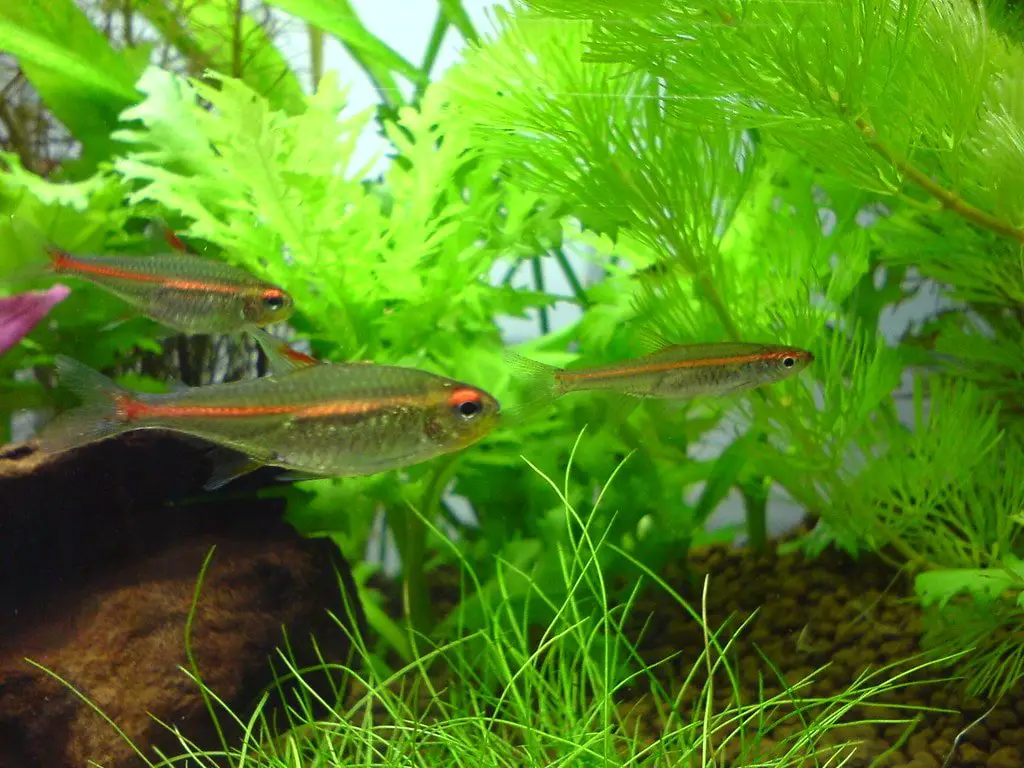
| Size | 1.5 inches max |
| Temperament | Peaceful |
| pH | 5 to 7 |
| Temperature | 70 to 85 °F |
Compatibility and Behavior
Rasboras are peaceful and make great Tank mates for GloFish. Their size of 1-1.5 inches is comparable and ensures safe cohabitation. They should be kept in groups of 6+ for social well-being.
Water Parameters
Rasboras prefer water with a pH of 6.0-7.5 and a temperature of 72-82°F, which aligns closely with GloFish care requirements.
Dietary Needs
Rasboras are omnivorous, easily accepting flake foods, frozen and live foods like brine shrimp, bloodworms, and daphnia. This diet is similar to GloFish Tetras nutrition.
Tank Size and Grouping
A 20-30 gallon tank provides sufficient room for the school of 6+ Rasboras and a group of GloFish while allowing for active swimming.
Visual Appeal and Community Dynamics
Rasboras display beautiful hues from electric blue to fire red against GloFish neon colors. Their peaceful social nature lends to a relaxing viewing of balanced interactions.
5. Neon Tetras
Neon tetras are small, brightly colored tetrafish known for their iconic blue and red hues and peaceful schooling nature.
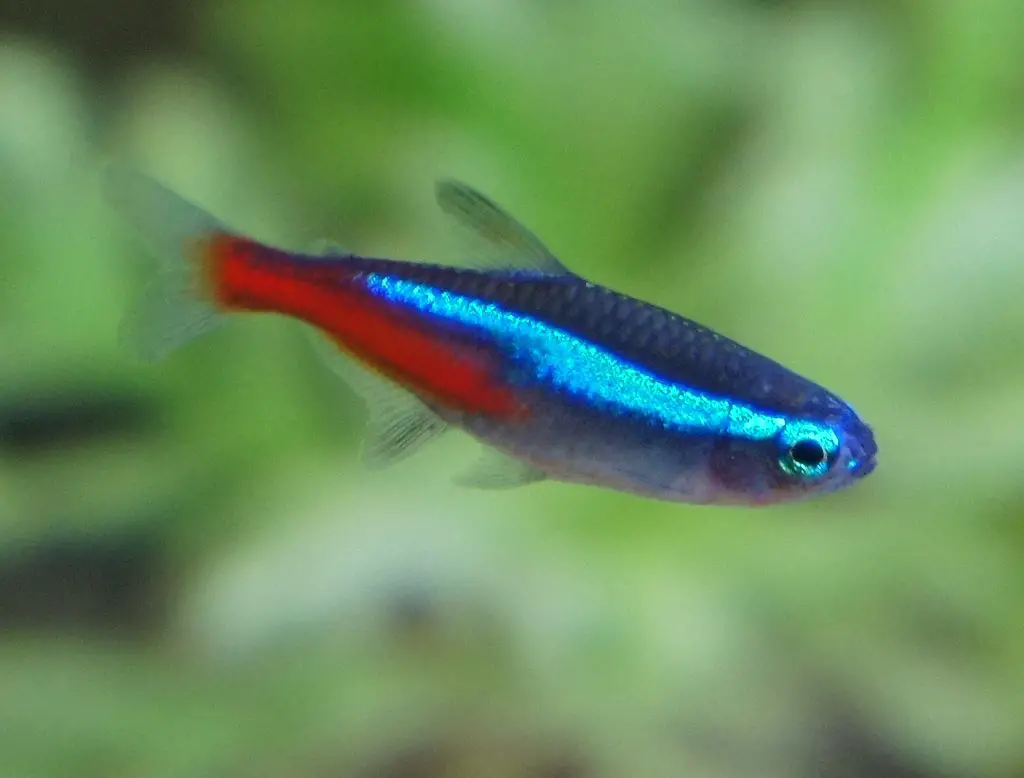
| Size | 1.30-2.0 inch |
| Temperament | quiet and community fish |
| pH | 6.5-7.0 |
| Temperature | 73-79 degrees Fahrenheit |
Compatibility and Behavior
Neon tetras are peaceful schooling fish with calm behaviors like foraging and grazing. Their 1-1.5 inches size matches well with similarly tempered GloFish Tetras.
Water Parameters
Neon and GloFish Tetras share preferences for temperatures of 72-79°F and a neutral pH of 6.5-7.5.
Dietary Needs
These omnivores readily accept flake foods and frozen brine shrimp, daphnia, and bloodworms as part of a varied diet.
Tank Size and Grouping
A 20-30 gallon provides ample room for two 6+ schools, which display colorful bands together amid decorations.
Visual Appeal and Community Dynamics
Bright neon and GloFish colors enliven tanks together while their calm, social natures provide a relaxing viewing of balanced school interactions.
6. Cardinal Tetras
Cardinal tetras are eye-catching fish featuring a striking red body coloration with a bold black stripe running vertically from the tail to the gills. Native to the Amazon basin, they are highly compatible as Tank mates for GloFish Tetras due to similarities in size, temperament, and care requirements.
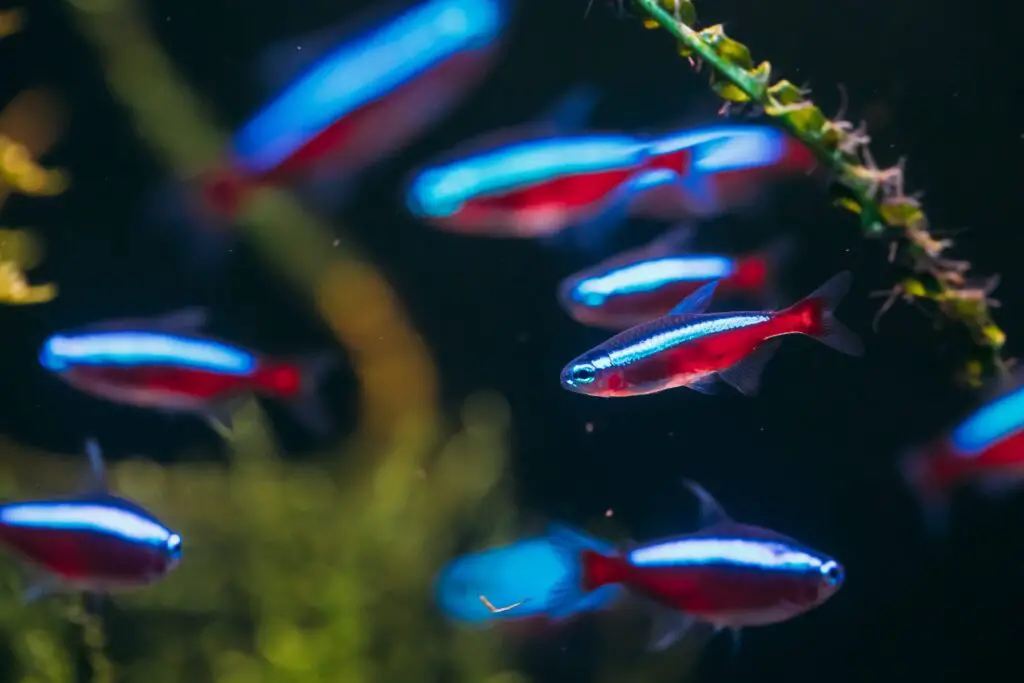
| Size | 1.2 inch |
| Temperament | quiet and community fish |
| pH | 4.6-6.2 |
| Temperature | 73-79 degrees Fahrenheit |
Compatibility and Behavior:
As peaceful community fish, Cardinal tetras school calmly alongside smaller species like rasboras and tetras. Groups maintain cohesion through coordinated movements. Their approximate 1-1.5 inch dimensions mesh well with comparably-sized GloFish.
Water Parameters:
Originating from soft, acidic Amazon waters, Cardinals prefer lower pH values between 4.6-6.2 when housed long-term. They also prefer warmer temperatures, thriving at 76-82°F, which aligns with the temperature tolerances of GloFish. This parameter range differs slightly from the neutral pH optimal for most GloFish, though the overlapping temperature range allows comfortable cohabitation.
Dietary Needs
An omnivorous diet suits their needs in the aquarium. Cardinals readily accept standard tropical flake foods and frozen brine shrimp, bloodworms, and daphnia intended for similarly-sized tetras.
Tank Size & Grouping:
An adequately sized aquarium of 20 gallons or more provides Cardinals the living space to demonstrate schooling and territorial behaviors naturally while housing multiple six-fish groups. Sufficient hiding places and breaks in the line of sight between territories help reduce stress.
Visual Appeal and Community Dynamics
Their brilliant red coloration and black stripes stand out vividly amid the neon of GloFish. Schools engage in synchronized swimming displays.
7. Corydoras Catfish
Corydoras catfish are most notable for their whisker-like barbels used to navigate and scavenge along the tank bottom. They exhibit a range of intriguing colors and patterns from bronze to green to albino. Highly compatible as Tank mates for peaceful GloFish.
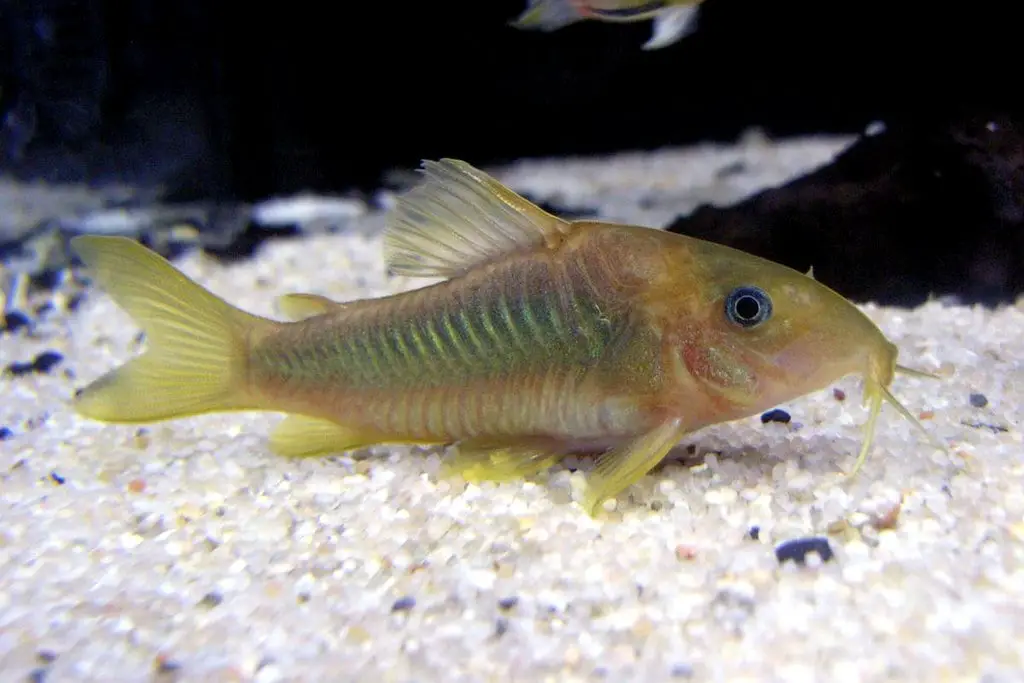
| Size | Around 2.5 inches |
| Temperament | Peaceful and pleasant |
| pH | 7 to 8 |
| Temperature | 60 to 75 ° F |
Compatibility and Behavior:
Placid bottom dwellers, corydoras calmly school and interact. Their smaller size of 2 inches allows comfortable coexistence with GloFish and community fish in a spacious environment.
Water Parameters:
Native to soft, acidic waters in South America, they favor a neutral pH range of 7.0-8.0 and a temperature of 72-82°F suitable for overlapping with GloFish’s needs.
Dietary needs
As opportunistic micro predators, they fulfill dietary needs on prepared foods, algae, vegetable matter, and aquatic invertebrates aligned for community tanks.
Tank Size and Grouping:
A minimum group of 5 or more in at least 20 gallons offers security and space for natural behaviors to flourish among aquatic plants and substrates.
Visual Appeal and Community Dynamics
Their catfish profiles and varied colors peeking from plant cover provide engaging natural displays. Large schools explore environments in unison.
8. Cherry Barbs
Cherry barbs are a spectacular choice for community aquariums. Their vibrant red coloring and energetic behaviors create a display complemented well by GloFish.
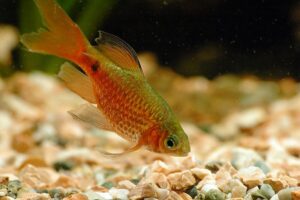
| Size | 2 inches max |
| Temperament | Peaceful |
| pH | 6 to 8 |
| Temperature | 73 °F to 81 °F |
Compatibility and Tank mates:
Cherry barbs have a generally peaceful nature and thrive alongside GloFish and other community fish of similar size. Their 1.5-2 inch stature allows harmonious cohabitation. However, males may turn territorial during breeding, so a 2F:1M ratio prevents aggression.
Water Parameters:
Native to Sri Lanka, cherry barbs prefer slightly acidic to neutral freshwater (pH 6.0-8.0) and temperatures of 72-82°F.
Diet:
Omnivorous cherry barbs readily accept prepared foods but also forage and may be offered frozen/live fare like bloodworms.
Tank Size and Grouping:
A minimum 20 gallon aquarium with plants provides sufficient space and security for a group of 6+ individuals to swim and school. Regular water changes maintain optimal conditions.
Visual Appeal and Community Dynamics:
Their brilliant red coloring and energetic schooling behaviors enhance aesthetic appeal. GloFish Tetras also add vibrant neon hues that complement the cherry barbs. Together these species provide lively activity that engages observers while remaining peaceful Tank mates.
9. Bristlenose Plecos
The Bristlenose Pleco is an excellent choice as a tank mate for GloFish, adding algae control while harmonizing in care requirements.
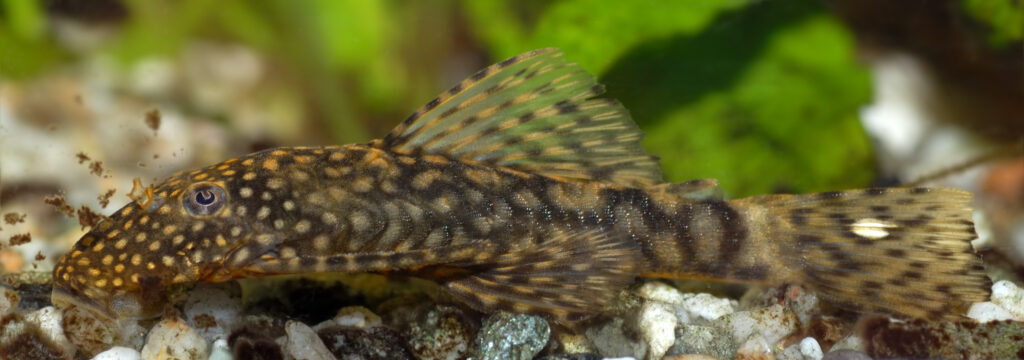
| Temperament | Shoaling fish
Peaceful |
| Size | 12 to 24 inches at maximum |
| The temperature of the water | 72 to 78 degrees Fahrenheit (15 C to 27 C) |
| the pH of the tank water | 7 to 8 |
The Bristlenose Pleco is an excellent choice as a tank mate for GloFish, adding algae control while harmonizing in care requirements.
Compatibility and Behavior:
Bristlenose Plecos are peaceful bottom dwellers well-suited to GloFish. They reach only 2-4 inches as adults. Bristlenoses spend their time grazing algae off surfaces, avoiding interaction with midwater GloFish.
Water Parameters:
Originating from South America, Bristlenoses thrive in water with a pH of 6.0-8.0 and a temperature range of 72-82°F, matching GloFish preferences.
Dietary Needs:
In the wild and in aquariums, Bristlenoses sustain themselves on algae and vegetable matter. They share a compatible diet with herbivorous/omnivorous GloFish.
Tank Size and Grouping:
A minimum 30-gallon tank provides ample floor space for multiple Bristlenoses to graze freely and control algae, benefiting water conditions for both species.
Visual Appeal and Community Dynamics:
Bristlenoses play an important role in ecosystem balance by consuming excess algae. Their grazing enhances visibility within the tank, allowing colorful GloFish to shine.
10. Guppies
Guppies make great Tank mates for GloFish Tetras, harmonizing in temperament care needs and adding vibrant color variation to the aquarium display.
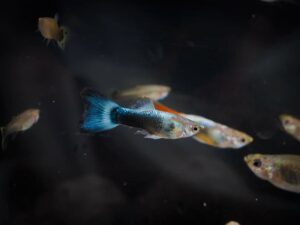
| Size | 1.5-2.5 inch |
| Temperament | Peaceful |
| pH | 6.8-7.8 |
| Temperature | 70 °F to 82 °F |
Compatibility and Behavior:
Guppies have peaceful dispositions, getting along well with other quiet species of comparable size, such as GloFish Tetras. Their small 1-2 inch stature complements brightly-hued GloFish Tetras well.
Water Parameters:
Native to South America, guppies prefer temperatures of 72-79°F within a slightly alkaline pH range of 7.0-8.0, matching GloFish Tetra water parameters.
Dietary Needs:
Their dietary needs parallel those of GloFish Tetras, finding harmony in flake foods, dried nutrients, and occasional live/frozen fare. This simplifies feeding.
Tank Size and Grouping:
A group of 6 or more guppies and 6+ GloFish Tetras thrive with adequate swimming space in 20 gallons or larger with plants and décor.
Visual Appeal and Community Dynamics:
Guppies contribute diverse, vibrant colors from orange to blue to the shimmering hues of GloFish Tetras, enhancing aesthetic interest.
11. Hoplo Catfish
The Hoplo Catfish from South America makes an excellent choice as a tank mate for GloFish Tetras due to their compatibility and peaceful nature.
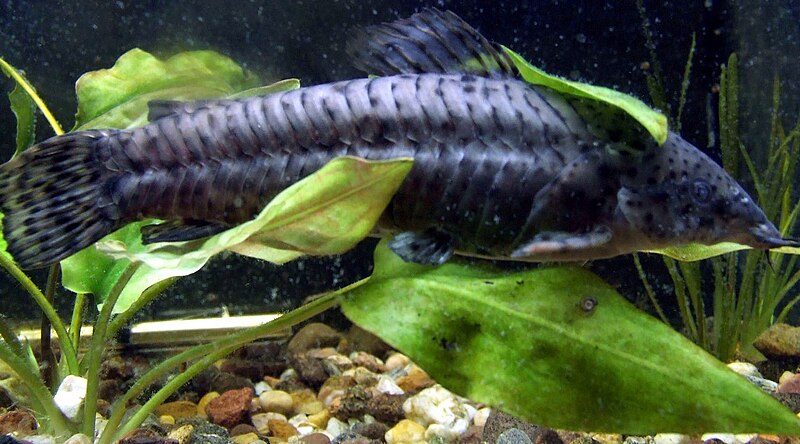
Compatibility and Behavior:
Reaching 6 inches as adults, Hoplo Catfish interact harmoniously with GloFish Tetras due to their preference for calm environments and non-aggressive behaviors.
Water Parameters:
Native to South America, Hoplo Catfish thrive in water with a pH between 6.0-8.0 and a temperature range of 72-86°F, which perfectly aligns with GloFish Tetras’ pH 6.0-8.0 and 72-86°F temperature requirements for a comfortable coexistence.
Tank size and groupings:
When jointly housed with attention to needs, Hoplo Catfish and GloFish Tetras create a vibrant yet tranquil community aquarium experience. Their contrasting color patterns and behaviors provide continuous visual interest from the substrate to midwater levels.
Visual Appeal and Community Dynamics:
When jointly housed with attention to needs, Hoplo Catfish and GloFish Tetras create a vibrant yet peaceful community aquarium experience. Their contrasting color patterns and behaviors provide continuous visual interest from the substrate to midwater levels.
12. Cheery Shrimp
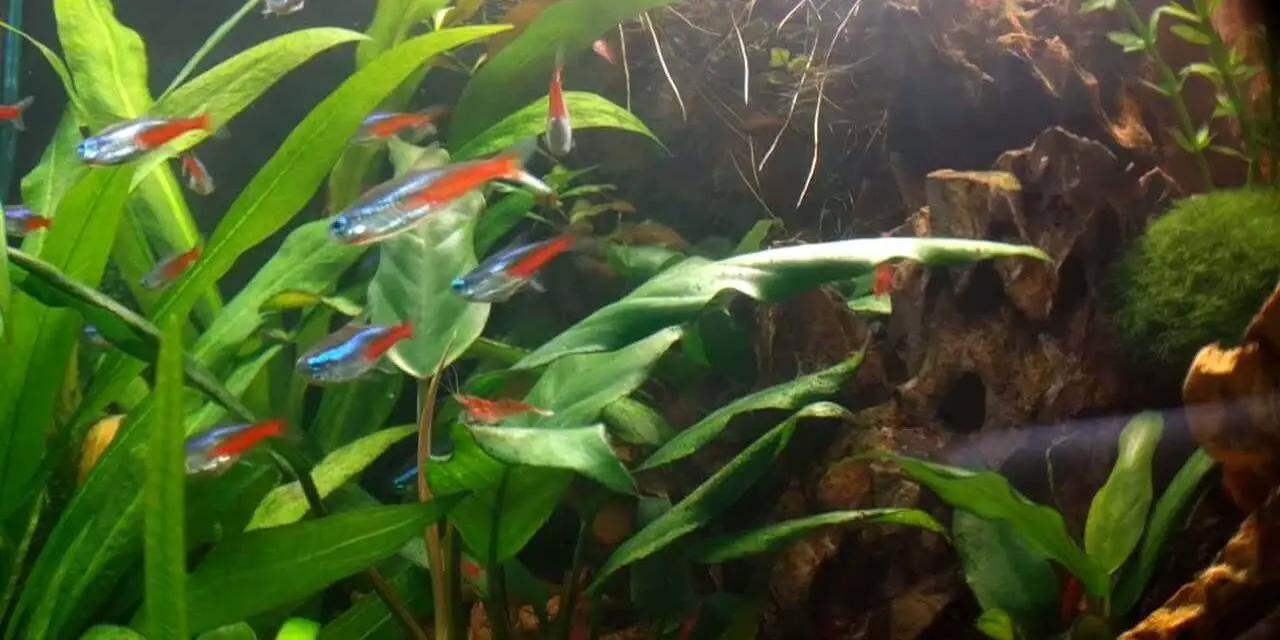
Cherry Shrimp, originating from Taiwan, are a delightful addition to any aquarium, and they make excellent companions for GloFish Tetras.
Compatibility and Behavior:
Despite their small 1.5-inch size, Cherry Shrimp are non-aggressive and get along well with GloFish Tetras due to their peaceful nature, which makes them suitable for beginners.
Water Parameters:
Cherry Shrimp have similar temperature preferences to GloFish Tetras, thriving in 65-85°F and a pH range of 6.0-8.0, allowing for a comfortable coexistence between the two species.
Dietary Needs:
Cherry Shrimp and GloFish Tetras share a balanced diet, including algae wafers, veggie flakes, and occasional live or frozen foods which simplifies feeding requirements.
Tank Size and Grouping:
Their minimal space needs mean Cherry Shrimp can be housed in smaller tanks, with 5 gallons minimum providing suitable space. A group of 6-10 shrimp is recommended to encourage natural behaviors.
Visual Appeal and Community Dynamics:
Their vibrant red hue contrasts beautifully with GloFish Tetras’ colors, creating an eye-catching aquatic display.
13. Dwarf Gourami
Dwarf Gouramis are a fantastic choice as tank mates for GloFish Tetras, adding vibrant colors and a diverse range of behaviors to your aquarium. Let’s explore why they are a great complement.
Compatibility and Behavior:
Dwarf Gouramis are generally peaceful, making them compatible with the tranquil nature of GloFish Tetras. Their small size and distinct coloration add an interesting dimension to the aquarium, complementing the playful disposition of GloFish Tetras.
Water Parameters:
Maintaining appropriate water conditions is vital. Dwarf Gouramis prefer a slightly acidic to neutral pH (6.0 – 7.5) and a temperature range of 77-82°F (25-28°C), which aligns well with the preferences of GloFish Tetras.
Dietary Needs:
Their diet primarily consists of flakes, pellets, and occasionally frozen or live foods. This dietary overlap simplifies feeding routines and ensures both species receive balanced nutrition.
Tank Size and Grouping:
A tank of 20 gallons or more is suitable for housing a community of GloFish Tetras and Dwarf Gouramis. Dwarf Gouramis are comfortable in groups of at least 3 to 5, showcasing their social interactions.
Visual Appeal and Community Dynamics:
The vibrant hues of Dwarf Gouramis, combined with their distinct body shapes and tranquil movements, create an engaging and visually pleasing aquatic environment. Their peaceful demeanor contributes to a harmonious community in the tank.
14. Mollies
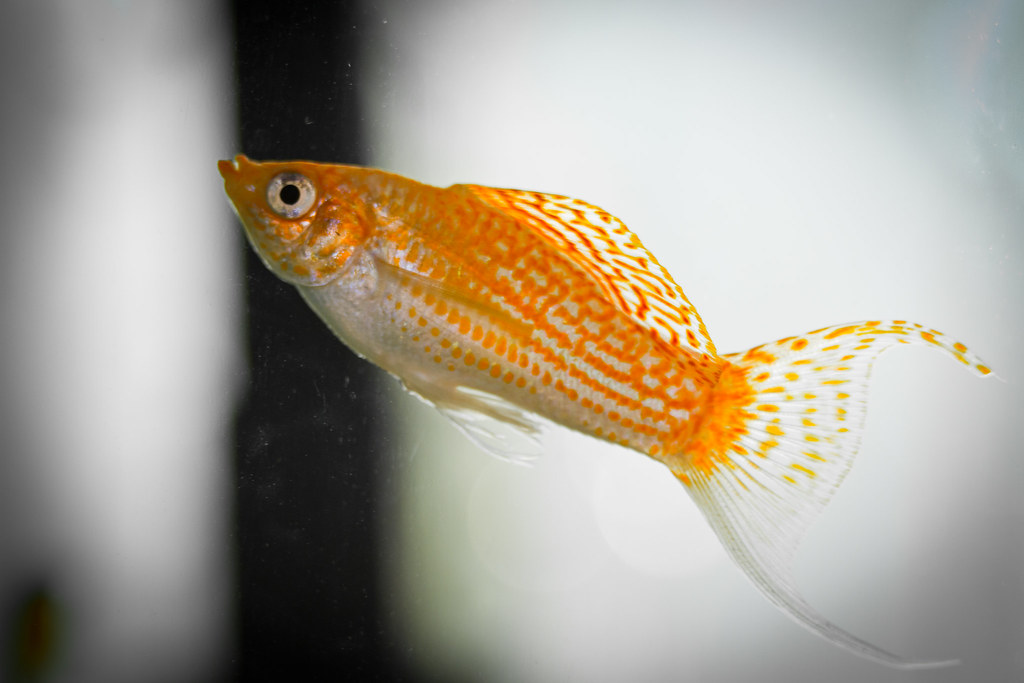
Mollies, belonging to the Poeciliidae family, stand as excellent Tank mates for GloFish Tetras, infusing a harmonious aquatic ambiance into your aquarium. Let’s delve into why they form an exceptional combination.
Compatibility and Behavior
Mollies share common traits in terms of behavior, diet, and water preferences with GloFish Tetras, establishing a strong foundation for compatibility. Their peaceful nature and social behavior make them ideal companions for a community tank, aligning perfectly with GloFish Tetras.
Water Parameters
To ensure a thriving environment, Mollies prefer a slightly alkaline pH (around 7.0 to 8.0) and a temperature range of 75-80°F (24-27°C), matching well with the preferences of GloFish Tetras.
Dietary Needs
Their dietary requirements are similar to those of GloFish Tetras, enjoying a diet consisting of flakes, micro pellets, and occasional live or frozen foods. This dietary harmony simplifies feeding routines and ensures both species receive balanced nutrition.
Tank Size and Grouping
Provide a tank of at least 20 gallons to accommodate a lively community of Mollies and GloFish Tetras. Mollies thrive in a social setting, so ensure a group of at least 4-6 to enhance their well-being and social dynamics.
Visual Appeal and Community Dynamics
The vibrant hues and graceful movements of Mollies, combined with the captivating colors of GloFish Tetras, create a visually engaging and lively aquatic community. The interplay of colors and behavior enhances the aesthetic appeal of your aquarium, offering a delightful spectacle.
15. Platies
The Platies, known for their vibrant colors and peaceful disposition, are a splendid choice as tank mates for GloFish Tetras. Let’s explore why this combination is a fantastic choice for your aquarium.
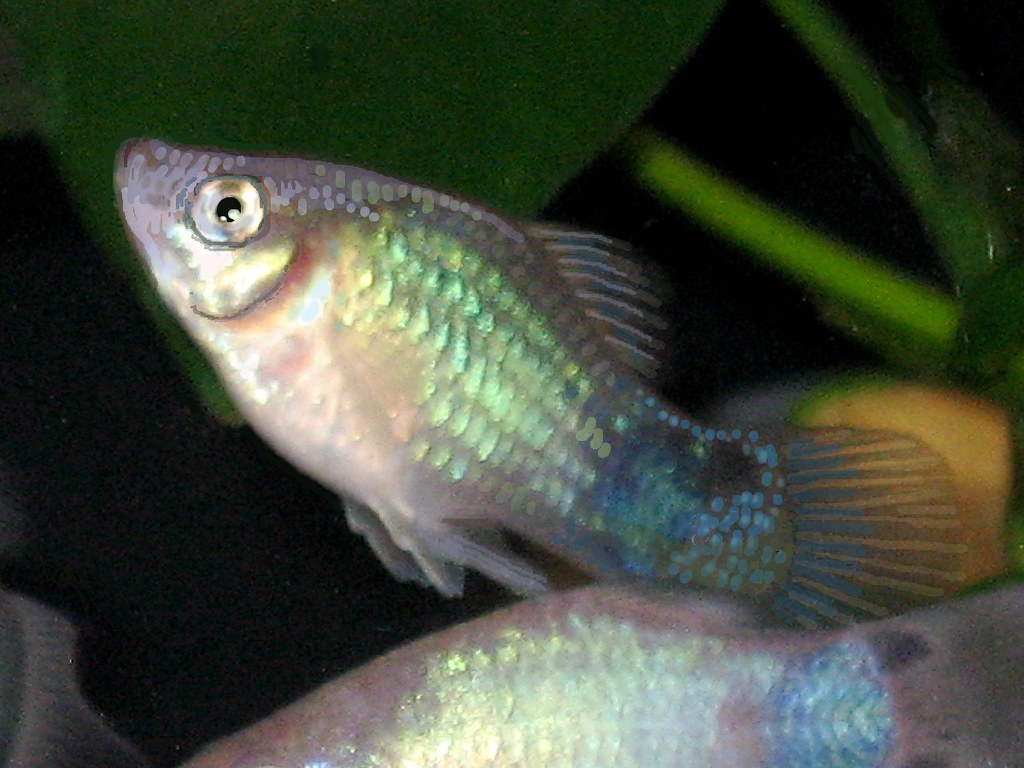
Compatibility and Temperament
Platies share a peaceful temperament, much like GloFish Tetras. Their lively behavior and vibrant colors add a joyful dynamic to your tank, perfectly aligning with the playful nature of GloFish Tetras.
Water Parameters
Platies thrive in slightly acidic to neutral pH levels (around 6.8 – 7.8) and are comfortable within a temperature range of 72-80°F (22-27°C). These water parameter preferences harmonize well with those of GloFish Tetras.
Dietary Needs
Their dietary requirements are quite similar to those of GloFish Tetras, encompassing flakes, micro pellets, and occasional live or frozen foods. This similarity simplifies feeding routines and ensures both species receive a well-rounded diet.
Tank Size and Grouping
For a harmonious community, a tank of 30-40 gallons or more is recommended to house a lively group of GloFish Tetras and Platies. Platies exhibit a preference for grouping, thriving in a community of at least 6, enhancing their social dynamics.
Visual Harmony and Aesthetic Appeal
The vibrant hues and active nature of Platies add a captivating contrast and visual appeal to the tank, complementing the dazzling colors of GloFish Tetras. Their tranquil demeanor and fondness for schooling contribute to a visually stunning and harmonious aquatic community.
Incompatible Tank Mates for GloFish Tetras
When selecting Tank mates for your GloFish Tetras, it’s important to avoid certain species that may not be compatible. Avoid aggressive fish, such as cichlids or larger predatory species that may harm or stress your GloFish. Also, avoid fish with different water requirements, as the wrong water parameters can cause stress and illness in your GloFish.
It’s also a good idea to avoid bottom-dwelling fish that may compete with your GloFish for food or territory. Additionally, some fish species may require a larger tank size than what is suitable for GloFish, so it’s important to consider the size and space requirements of potential Tank mates. You can create a peaceful and thriving fish community in your GloFish tank with some research and consideration.
Some of the Tank mates to avoid are:
- Big Catfish
- Malawi Cichlid
- Tanganyika Cichlid
- African Cichlid
- Goldfish
- Angel Fish
- Oscars
- Flowerhorn
Do GloFish Tetras Need Tank Mates?
GloFish Tetras require Tank mates as they are schooling fish and thrive in the presence of their own kind or other compatible ones. When kept alone without any Tank mates, they can experience significant stress, leading to health issues and a shorter lifespan. It is crucial to provide GloFish Tetras with companions to mimic their natural behavior and create a secure and comfortable environment.
Pet stores that prioritize the well-being of the fish will typically sell GloFish Tetras in groups of three, five, or ten. This is because these stores understand the importance of maintaining a proper school size to promote the overall health and happiness of the fish. By being in a group, GloFish Tetras can engage in schooling behavior, which reduces stress and increases their sense of security.
Also Read: How Long Do GloFish Tetra Live
Benefits Of Having Tankamates For Your GloFish Tetras
1. Asthetic Appeal
Combining GloFish Tetras with other fish species can greatly enhance the visual charm of your aquarium. This synergy creates a beautiful illustration of colors and patterns. The striking colorings of GloFish Tetras complement and contrast beautifully with the unique aesthetics of their Tank mates. This harmonious blend not only makes the aquarium more visually appealing but also provides a delightful spectacle for guests. The dynamic interplay of colors and forms in the tank can transform it into a living work of art that adds an element of elegance and charm to any space.
2. Companionship
Tank mates offer companionship to GloFish Tetras by sharing the aquatic space and engaging in interactions. When kept with other compatible species, Tetras exhibit fascinating behaviors, such as synchronized swimming and playful darting between plants and decorations. This communal environment not only mirrors their natural habitat but also provides them with a sense of security and camaraderie. Ultimately, having Tank mates in your aquarium can create a more engaging and fulfilling social environment for your GloFish Tetras.
3. Reduce Stress
GloFish are naturally social and thrive when they have company. Tank mates offer not only companionship but also a sense of security. When kept with peaceful companions, GloFish Tetras tend to exhibit soothing behaviors, such as swimming more confidently and engaging in group activities like schooling. These interactions reduce anxiety and promote a more harmonious and stress-free aquarium environment.
It’s essential, though, to strike a balance and avoid overcrowding, as this can, ironically, lead to stress.
4. Enhanced Breeding
Tank mates play a crucial role in creating a conducive breeding environment for GloFish Tetras. They provide a sense of security and reduce stress, which is essential for successful reproduction. Additionally, the presence of compatible Tank mates can trigger GloFish Tetras to exhibit their natural courtship and spawning behaviors.
During breeding, GloFish Tetras often display synergistic behaviors with their Tank mates. For instance, they may engage in group spawning activities, with Tank mates also contributing to the process by releasing their eggs and milt. This collaborative behavior can lead to more successful breeding events in the aquarium.
Also Read: How To Tell If your GloFish Tetra is Male Or Female
Conclusion
In conclusion, choosing the right GloFish Tetra Tank mates is essential to ensure a harmonious and thriving aquarium. Neon tetras, Corydoras catfish, cherry barbs, bristlenose plecos, and guppies are all great options that coexist peacefully with your GloFish.
Remember to research each species thoroughly to ensure they have similar care requirements and compatible temperaments before introducing them to your aquarium. With proper care and consideration, you can create a beautiful and vibrant aquarium that you and your fish will love.
